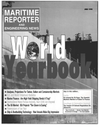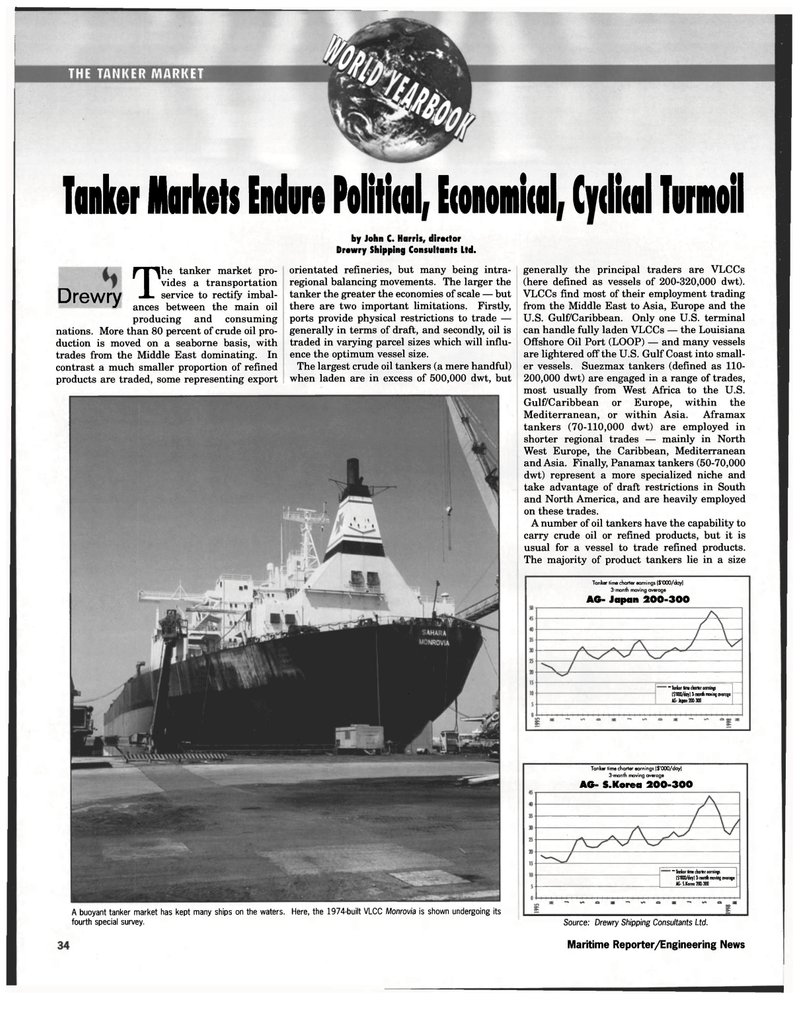
Page 34: of Maritime Reporter Magazine (June 1998)
Read this page in Pdf, Flash or Html5 edition of June 1998 Maritime Reporter Magazine
Tanker time charter earnings ($'000/day) 3-month moving average
AG- S.Korea 200-300 ~ Tanker time charter earnings ($'000/day) 3-month moving average
AG- S.Korea 200-300
Tanker Markets Endure Political, Economical, Cyclical Turmoil
by John C. Harris, dire Drewry Shipping Consultants Ltd.
Source: Drewry Shipping Consultants Ltd.
Maritime Reporter/Engineering News
A buoyant tanker market has kept many ships on the waters. Here, the 1974-built VLCC Monrovia is shown undergoing its
fourth special survey.
Drewry T JL. £ ances
Ihe tanker market pro-
vides a transportation
service to rectify imbal-
between the main oil
producing and consuming
nations. More than 80 percent of crude oil pro-
duction is moved on a seaborne basis, with
trades from the Middle East dominating. In
contrast a much smaller proportion of refined
products are traded, some representing export
orientated refineries, but many being intra-
regional balancing movements. The larger the
tanker the greater the economies of scale — but
there are two important limitations. Firstly,
ports provide physical restrictions to trade —
generally in terms of draft, and secondly, oil is
traded in varying parcel sizes which will influ-
ence the optimum vessel size.
The largest crude oil tankers (a mere handful)
when laden are in excess of 500,000 dwt, but
generally the principal traders are VLCCs
(here defined as vessels of 200-320,000 dwt).
VLCCs find most of their employment trading
from the Middle East to Asia, Europe and the
U.S. Gulf/Caribbean. Only one U.S. terminal
can handle fully laden VLCCs — the Louisiana
Offshore Oil Port (LOOP) — and many vessels
are lightered off the U.S. Gulf Coast into small-
er vessels. Suezmax tankers (defined as 110-
200,000 dwt) are engaged in a range of trades,
most usually from West Africa to the U.S.
Gulf/Caribbean or Europe, within the
Mediterranean, or within Asia. Aframax
tankers (70-110,000 dwt) are employed in
shorter regional trades — mainly in North
West Europe, the Caribbean, Mediterranean
and Asia. Finally, Panamax tankers (50-70,000
dwt) represent a more specialized niche and
take advantage of draft restrictions in South
and North America, and are heavily employed
on these trades.
A number of oil tankers have the capability to
carry crude oil or refined products, but it is
usual for a vessel to trade refined products.
The majority of product tankers lie in a size
Tanker time charter earnings ($'000/day)
3-month moving average
AG- Japan 200-300
" Tanker time charier earnings
($'000/day) 3-month moving average
AG-Japan 200-300

 33
33

 35
35
